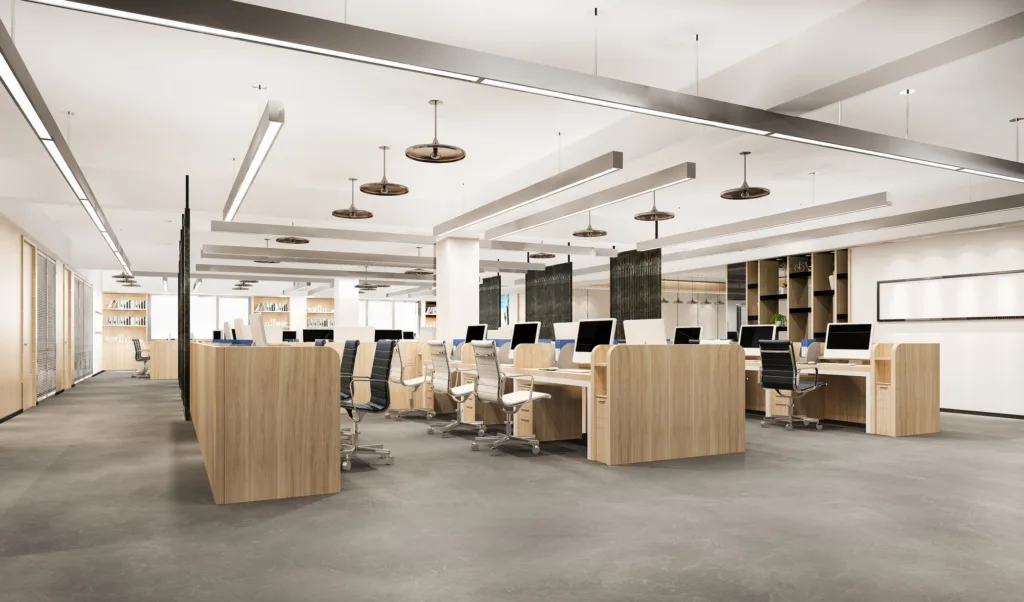Open landschapskantoren
Tips voor een doordachte inrichting

Landschapskantoren krijgen steeds vaker kritiek. Het gebrek aan privacy, geluidsoverlast en een verminderde concentratie behoren tot de belangrijkste klachten. Toch blijven veel organisaties vasthouden aan dit concept vanwege kostenbesparing en de flexibiliteit die het biedt.
Maar hoe zorg je ervoor dat een landschapskantoor (beter) werkt voor de medewerkers? Het antwoord ligt in een doordachte inrichting en slim ontwerp.
Inhoudsopgave
Wat maakt landschapskantoren problematisch?
Hoewel open kantoren oorspronkelijk bedoeld waren om samenwerking te bevorderen, wijzen onderzoeken uit dat ze vaak een averechts effect hebben. Het gebrek aan controle over de werkomgeving kan leiden tot frustraties, stress en zelfs gezondheidsproblemen. Hier zijn de belangrijkste pijnpunten:
Geluidsoverlast
Een van de meest voorkomende klachten is het hoge geluidsniveau. Gesprekken, telefoongesprekken en andere kantooractiviteiten zorgen voor constante afleiding. Zelfs alledaagse geluiden, zoals typen of het schuiven van stoelen, kunnen storend werken.
Wij kunnen je helpen.
Gebrek aan privacy
In een open kantoorruimte zijn er weinig plekken om ongestoord te werken of een vertrouwelijk gesprek te voeren. Dit gebrek aan persoonlijke ruimte kan medewerkers het gevoel geven dat ze continu ‘aan’ moeten staan.
Visuele afleiding
Bewegingen in het zichtveld, zoals collega’s die rondlopen of schermen die oplichten, leiden tot onderbrekingen en verminderde concentratie.
Gezondheidsklachten
Slechte werkhoudingen door niet-aangepaste werkplekken en een gebrek aan beweging verhogen het risico op klachten zoals rugpijn, nekklachten en vermoeidheid.
Mentale belasting
De constante blootstelling aan prikkels in een open ruimte verhoogt het stressniveau.
Hoe doordachte inrichting landschapskantoren kan verbeteren
Met slimme aanpassingen kan men een landschapskantoor verbeteren. Hier zijn enkele strategieën om dit te bereiken:
Optimaliseer de akoestiek
Geluidsoverlast is een belangrijke bron van irritatie. Oplossingen zoals akoestische panelen, vloerbedekking en plantenwanden kunnen het geluidsniveau aanzienlijk verlagen. Daarnaast helpt het creëren van stiltezones medewerkers zich beter te concentreren.
Zorg voor flexibele werkplekken
Werkplekken moeten zich aanpassen aan de gebruiker, niet andersom. Verstelbare bureaus en ergonomische stoelen zorgen ervoor dat medewerkers comfortabel kunnen werken. Door zit-sta werkplekken aan te bieden, wordt bovendien de beweging gestimuleerd, wat goed is voor de gezondheid.
Creëer verschillende zones
Een goede werkplek biedt diversiteit: zones voor samenwerken, ruimtes voor gefocust werk en plekken om te ontspannen. Dit geeft medewerkers de vrijheid om een werkplek te kiezen die past bij hun behoeften en taken.
Geef medewerkers controle
Het gevoel van controle over de werkomgeving kan stress verminderen. Dit kan gaan om de mogelijkheid om stoelen en bureaus aan te passen, maar ook om toegang tot hulpmiddelen zoals noise cancelling koptelefoons en goed uitgeruste focusruimtes.
Stimuleer beweging en pauzes
Lange periodes van zitten verhogen het risico op gezondheidsklachten. Werkgevers kunnen dit tegengaan door het kantoor slim in te richten. Ook kan een aantrekkelijke pauzeplek bijdragen aan ontspanning.
Investeer in begeleiding
Het introduceren van ergonomische werkplekken is slechts een deel van de oplossing. Het is essentieel dat medewerkers leren hoe ze die optimaal gebruiken. Opleiding en sensibilisering over het correct instellen van de werkplek is hoog noodzakelijk.
Conclusie
Het succes van een kantoorruimte valt of staat met de mate waarin het is afgestemd op de behoeften van de medewerkers. Met een focus op ergonomie kan zelfs een dynamische, open werkomgeving zorgen voor tevreden en productieve werknemers.
Onze ergonomie consultants staan klaar om jouw organisatie te begeleiden bij het creëren van gezonde werkplekken. Met op maat gemaakte adviezen en slimme oplossingen zorgen we ervoor dat je kantooromgeving een plek wordt waar medewerkers graag en gezond werken.
Benieuwd hoe we jouw landschapskantoor kunnen verbeteren? Neem contact met ons op en ontdek de mogelijkheden!
Op zoek naar duidelijkheid?
Prevom heeft de expertise die u zoekt.
Wij informeren u graag over de mogelijkheden!